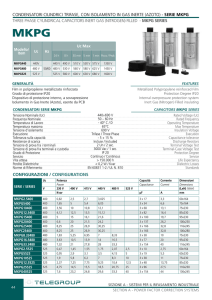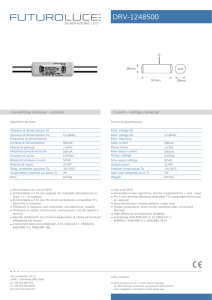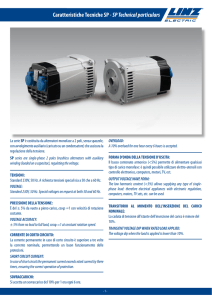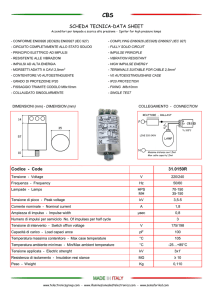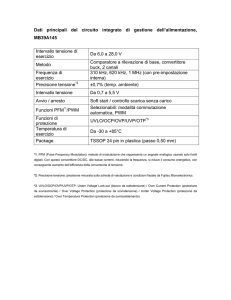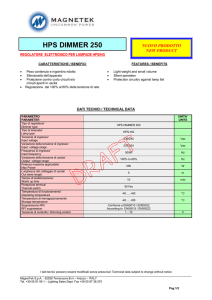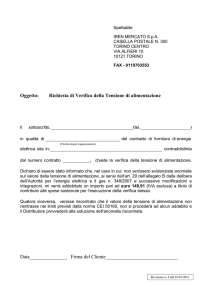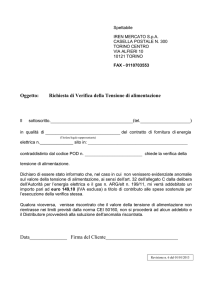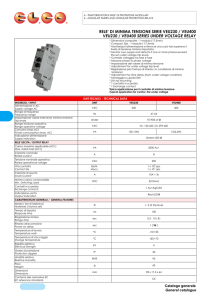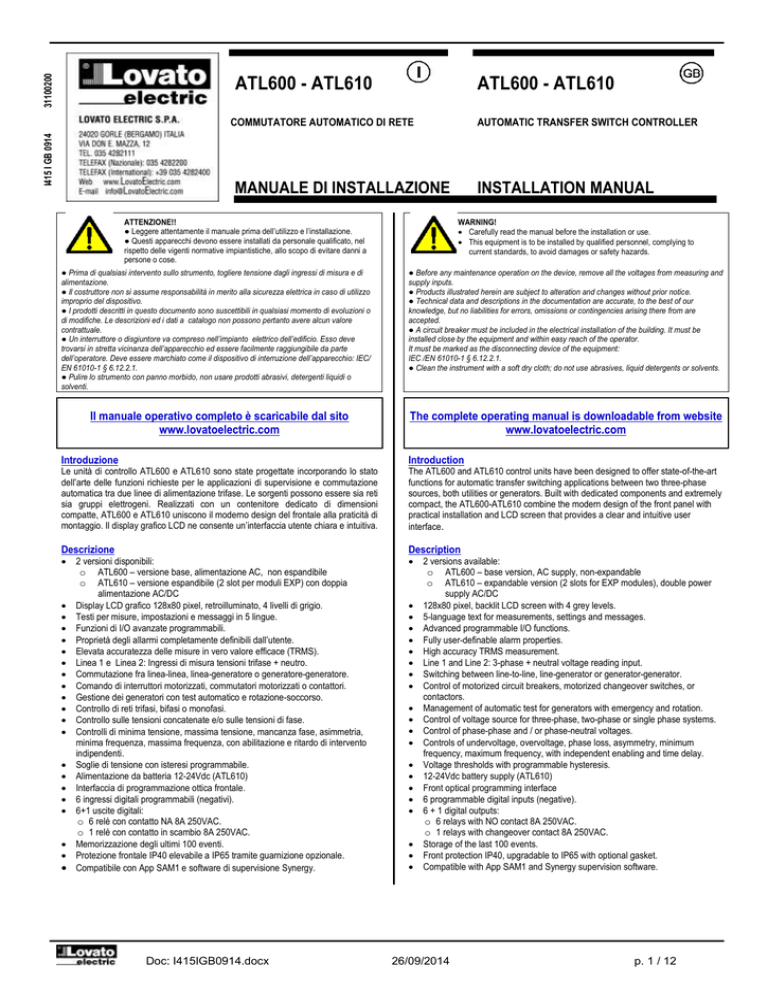
31100200
ATL600 - ATL610
ATL600 - ATL610
I415 I GB 0914
COMMUTATORE AUTOMATICO DI RETE
AUTOMATIC TRANSFER SWITCH CONTROLLER
MANUALE DI INSTALLAZIONE
ATTENZIONE!!
● Leggere attentamente il manuale prima dell’utilizzo e l’installazione.
● Questi apparecchi devono essere installati da personale qualificato, nel
rispetto delle vigenti normative impiantistiche, allo scopo di evitare danni a
persone o cose.
● Prima di qualsiasi intervento sullo strumento, togliere tensione dagli ingressi di misura e di
alimentazione.
● Il costruttore non si assume responsabilità in merito alla sicurezza elettrica in caso di utilizzo
improprio del dispositivo.
● I prodotti descritti in questo documento sono suscettibili in qualsiasi momento di evoluzioni o
di modifiche. Le descrizioni ed i dati a catalogo non possono pertanto avere alcun valore
contrattuale.
● Un interruttore o disgiuntore va compreso nell’impianto elettrico dell’edificio. Esso deve
trovarsi in stretta vicinanza dell’apparecchio ed essere facilmente raggiungibile da parte
dell’operatore. Deve essere marchiato come il dispositivo di interruzione dell’apparecchio: IEC/
EN 61010-1 § 6.12.2.1.
● Pulire lo strumento con panno morbido, non usare prodotti abrasivi, detergenti liquidi o
solventi.
Il manuale operativo completo è scaricabile dal sito
www.lovatoelectric.com
INSTALLATION MANUAL
WARNING!
Carefully read the manual before the installation or use.
This equipment is to be installed by qualified personnel, complying to
current standards, to avoid damages or safety hazards.
● Before any maintenance operation on the device, remove all the voltages from measuring and
supply inputs.
● Products illustrated herein are subject to alteration and changes without prior notice.
● Technical data and descriptions in the documentation are accurate, to the best of our
knowledge, but no liabilities for errors, omissions or contingencies arising there from are
accepted.
● A circuit breaker must be included in the electrical installation of the building. It must be
installed close by the equipment and within easy reach of the operator.
It must be marked as the disconnecting device of the equipment:
IEC /EN 61010-1 § 6.12.2.1.
● Clean the instrument with a soft dry cloth; do not use abrasives, liquid detergents or solvents .
The complete operating manual is downloadable from website
www.lovatoelectric.com
Introduzione
Introduction
Descrizione
Description
Le unità di controllo ATL600 e ATL610 sono state progettate incorporando lo stato
dell’arte delle funzioni richieste per le applicazioni di supervisione e commutazione
automatica tra due linee di alimentazione trifase. Le sorgenti possono essere sia reti
sia gruppi elettrogeni. Realizzati con un contenitore dedicato di dimensioni
compatte, ATL600 e ATL610 uniscono il moderno design del frontale alla praticità di
montaggio. Il display grafico LCD ne consente un’interfaccia utente chiara e intuitiva.
2 versioni disponibili:
o ATL600 – versione base, alimentazione AC, non espandibile
o ATL610 – versione espandibile (2 slot per moduli EXP) con doppia
alimentazione AC/DC
Display LCD grafico 128x80 pixel, retroilluminato, 4 livelli di grigio.
Testi per misure, impostazioni e messaggi in 5 lingue.
Funzioni di I/O avanzate programmabili.
Proprietà degli allarmi completamente definibili dall’utente.
Elevata accuratezza delle misure in vero valore efficace (TRMS).
Linea 1 e Linea 2: Ingressi di misura tensioni trifase + neutro.
Commutazione fra linea-linea, linea-generatore o generatore-generatore.
Comando di interruttori motorizzati, commutatori motorizzati o contattori.
Gestione dei generatori con test automatico e rotazione-soccorso.
Controllo di reti trifasi, bifasi o monofasi.
Controllo sulle tensioni concatenate e/o sulle tensioni di fase.
Controlli di minima tensione, massima tensione, mancanza fase, asimmetria,
minima frequenza, massima frequenza, con abilitazione e ritardo di intervento
indipendenti.
Soglie di tensione con isteresi programmabile.
Alimentazione da batteria 12-24Vdc (ATL610)
Interfaccia di programmazione ottica frontale.
6 ingressi digitali programmabili (negativi).
6+1 uscite digitali:
o 6 relè con contatto NA 8A 250VAC.
o 1 relè con contatto in scambio 8A 250VAC.
Memorizzazione degli ultimi 100 eventi.
Protezione frontale IP40 elevabile a IP65 tramite guarnizione opzionale.
Compatibile con App SAM1 e software di supervisione Synergy.
Doc: I415IGB0914.docx
The ATL600 and ATL610 control units have been designed to offer state-of-the-art
functions for automatic transfer switching applications between two three-phase
sources, both utilities or generators. Built with dedicated components and extremely
compact, the ATL600-ATL610 combine the modern design of the front panel with
practical installation and LCD screen that provides a clear and intuitive user
interface.
2 versions available:
o ATL600 – base version, AC supply, non-expandable
o ATL610 – expandable version (2 slots for EXP modules), double power
supply AC/DC
128x80 pixel, backlit LCD screen with 4 grey levels.
5-language text for measurements, settings and messages.
Advanced programmable I/O functions.
Fully user-definable alarm properties.
High accuracy TRMS measurement.
Line 1 and Line 2: 3-phase + neutral voltage reading input.
Switching between line-to-line, line-generator or generator-generator.
Control of motorized circuit breakers, motorized changeover switches, or
contactors.
Management of automatic test for generators with emergency and rotation.
Control of voltage source for three-phase, two-phase or single phase systems.
Control of phase-phase and / or phase-neutral voltages.
Controls of undervoltage, overvoltage, phase loss, asymmetry, minimum
frequency, maximum frequency, with independent enabling and time delay.
Voltage thresholds with programmable hysteresis.
12-24Vdc battery supply (ATL610)
Front optical programming interface
6 programmable digital inputs (negative).
6 + 1 digital outputs:
o 6 relays with NO contact 8A 250VAC.
o 1 relays with changeover contact 8A 250VAC.
Storage of the last 100 events.
Front protection IP40, upgradable to IP65 with optional gasket.
Compatible with App SAM1 and Synergy supervision software.
26/09/2014
p. 1 / 12
Funzioni dei tasti frontali
Front buttons functions
LED frontali
LED modalità AUT (verde) – indica la modalità automatica attiva.
Front LED
LED di allarme (rosso) – Lampeggiante, indica che un allarme è attivo.
LED presenza tensione linea 1 (verde) – indica che la tensione della linea 1 rientra
nei limiti impostati
LED presenza tensione linea 2 (verde) – indica che la tensione della linea 2 rientra
nei limiti impostati
LED Stato interruttore linea 1 (giallo) – Se fisso, indica lo stato aperto o chiuso
dell’ interruttore linea 1. Se lampeggiante indica una incongruenza tra lo stato
desiderato dell’ATL600 e lo stato vero rilevato dal segnale di feedback.
LED Stato interruttore linea 2 (giallo) – Se fisso, indica lo stato aperto o chiuso
dell’ interruttore linea 2. Se lampeggiante indica una incongruenza tra lo stato
desiderato dell’ATL600 e lo stato vero rilevato dal segnale di feedback.
AUT LED (green) – Indicates that the automatic mode is active.
Alarm LED (red) – Flashing, indicates an active alarm.
Line 1 voltage status LED (green) - indicates that the line voltage source 1 is
within the programmed limits.
Line 2 voltage status LED (green) - indicates that the line voltage source 2 is
within the programmed limits.
Line 1 breaker status LED (yellow) - If I steady indicates the open or closed state
of the source line 1 breaker. If flashing, indicates a mismatch between the desired
state of the breaker and its true state detected by the feedback input.
Line 2 breaker status LED (yellow) - If I steady indicates the open or closed state
of the source line 2 breaker. If flashing, indicates a mismatch between the desired
state of the breaker and its true state detected by the feedback input.
Modi operativi
Operating modes
Tasto OFF – Selezione del modo operativo OFF.
Tasto AUT – Selezione del modo operativo automatico.
Tasto MAN – Selezione del modo operativo manuale.
Tasti ▲e ▼- Servono per scorrere le pagine del display o per selezionare la lista di
opzioni di un menu. Premendo contemporaneamente ▼+ ▲si richiama il Menu
principale con le icone rotanti.
Modo OFF - In questa modalità l’apparecchio risulta disabilitato, e non intraprende
nessuna azione. Tutte le visualizzazioni sia delle misure che dei LED di stato
rimangono attive. Se il comando dei dispositivi di commutazione è di tipo impulsivo,
in modo OFF entrambi i comandi apertura/chiusura rimangono disattivati. Se invece
è in modalità comando continuo, il comportamento può essere selezionato tramite
P05.10. Per poter accedere ai menu di programmazione è sempre necessario
spostarsi preventivamente in modalità OFF. Premendo sul tasto OFF-RESET si
possono azzerare gli allarmi ritenitivi, a patto che le condizioni che hanno generato
l’allarme siano state rimosse.
Modo MAN (manuale) - è possibile comandare manualmente gli interruttori
selezionando sul display l’interruttore che si vuol comandare premendo il tasto MAN,
e premendo ▲o ▼per confermare l’operazione di chiusura o di apertura.
Mentre è abilitata la chiusura-apertura degli interruttori, lo scorrimento delle pagine è
bloccato. Premendo più volte MAN è possibile sbloccarlo e spostarsi su altre pagine.
Se viene comandata manualmente la chiusura di un interruttore mentre l’altro è
ancora chiuso, l’apparecchio procederà prima all’apertura dell’altro interruttore e poi
alla chiusura di quello comandato, interponendo il tempo di interblocco
programmato.
Tensione Linea 1
OFF button - Selects the OFF operating mode.
AUT button - Selects the automatic mode.
MAN button - Select the manual operating mode.
▲ and ▼ keys - Used to scroll through the display pages or to select the list of
options in a menu. Simultaneously pressing ▼ + ▲ calls up the Main menu with
rotating icons.
OFF Mode - In this mode the device is disabled, and does not take any action. All
views, both of the measures of the status LEDs remain active. If the control of the
switching devices is impulsive, in OFF mode both open and close commands are
disabled. If instead it is in continuous mode, the behaviour can be selected by
P05.10. To access the programming menu is always necessary to enter in advance
the OFF mode. Pressing the OFF-RESET button resets the retentive alarms,
provided that the conditions that generated the alarm has been removed.
MAN mode (manual) - In MAN mode, you can manually control the switches on the
display by selecting the switch that you want to control by pressing the MAN key,
and pressing the ▲ or ▼ button to confirm the operation of closing or opening.
While the opening-closing of the breakers is enabled, the page scroll is locked.
Pressing MAN several times it is possible to unlock it and to move through other
display pages.
If is controlled manually closing a switch while the other is still closed, the unit will
proceed before the opening of the other switch and then to the closure of the
commanded one, inserting the interlock time programmed.
Tensione Linea 2
Voltage Line 1
Interruttore 1
selezionato
Funzione
selezionabile con
MAN
Scorrimento pagine
bloccato
Quando si lavora con dei gruppi elettrogeni, è possibile comandare manualmente
l’accensione e lo spegnimento del generatore in modo analogo a quanto descritto
per gli interruttori, ma spostandosi sulla pagina start/stop gruppi.
Tensione Linea 1
Tensione Linea 2
Voltage Line 2
Breaker 1 selected
Page scroll locked
Function selectable
with MAN
When working with the generators, you can manually control the switching on and
off of the generator in a manner similar to that described for switches, but moving on
the page start / stop groups.
Voltage Line 1
Voltage Line 2
Line 2 selected
Linea 2 selezionata
Funzione
selezionabile con
MAN
Scorrimento pagine
bloccato
Modo AUT (Automatico) - La modalità AUT è evidenziata dalla accensione del
corrispondente LED verde. In modalità automatico l’apparecchio segue
autonomamente sia le operazioni di apertura e chiusura degli interruttori sia
l’avviamento e l’arresto di eventuali gruppi elettrogeni.
Quando la linea prioritaria esce dai limiti, per un tempo superiore a quelli di ritardo
impostati (LED verde presenza linea spento), l’apparecchio scollega il carico dalla
linea prioritaria e lo collega alla linea secondaria, gestendo sia l’avviamento
dell’eventuale gruppo elettrogeno sia i tempi di manovra e di interblocco. E’ possibile
programmare l’apparecchio in modo da aprire l’interruttore dalla linea prioritaria
prima oppure dopo che la linea alternativa si è resa disponibile tramite il parametro
P05.05 nel menù M05 Commutazione.
Quando la linea prioritaria rientra nei limiti, l’apparecchio ricommuta il carico su di
essa e provvede all’eventuale ciclo di raffreddamento del gruppo elettrogeno. E’
possibile inoltre impostare il blocco del ritorno automatico su linea prioritaria tramite
il parametro P05.12.
I cicli di funzionamento in automatico variano sia in funzione del tipo di applicazione
(rete-rete, rete-gruppo, gruppo-gruppo) che in funzione del tipo di dispositivi di
commutazione impiegati (interruttori motorizzati,
commutatori motorizzati o contattori).
Doc: I415IGB0914.docx
Page scroll locked
Selectable function
with MAN
AUT mode (Automatic) - The AUT mode is highlighted by the lighting of the
corresponding green LED. In automatic mode, the unit manages automatically the
opening and closing of the breakers and the starting and stopping of generator sets.
When the priority line voltage is out of bounds for a time longer than those set (line
presence green LED turns off), the unit disconnects the load from the priority line
and connect it to the secondary line, managing both start-up of any generator and
interlock time delay. It is possible to program the unit to open the priority line breaker
before or after the secondary line has been made available, through parameter
P05.05 in the M05 Changeover menu.
When the priority line comes back within the limits, the unit will switch back the load
on it and decide the possible cooling cycle of the generator. It is possible also to
lock the automatic return to the priority line by means of parameter P05.12.
The cycles of automatic operation vary according to the type of application (utilityutility, utility-generator, generator-generator) and depending on the type of switching
devices used (motorized breakers, motorized changeovers, contactors).
26/09/2014
p. 2 / 12
Messa in tensione
Power-up
Menu principale
Main menu
Espandibilità
Expandability
La configurazione attuale del sistema è visualizzata nella apposita pagina del
display (moduli espansione), dove si vedono il numero, il tipo e lo stato dei moduli
collegati.
La numerazione degli I/O viene elencata sotto ogni modulo.
Lo stato (attivato/disattivato) degli I/O e dei canali di comunicazione viene
evidenziato con la scritta in negativo.
The actual system configuration is shown in the dedicated page of the display
(expansion modules), where it is possible to see the number, the type and the
status of the modules.
The I/O numbering is shown under each module.
The I/O status (active/not active) and communication channel status is highlighted
with a reverse code.
ATL600 ha alimentazione 100-240VAC.
ATL610 ha alimentazione 100-240VAC o 12-24VDC. In caso di presenza
contemporanea di entrambe le alimentazioni, viene data priorità alla
alimentazione AC.
Alla accensione l’apparecchio si pone normalmente in modo OFF.
Se si necessita che mantenga lo stesso modo di funzionamento precedente lo
spegnimento, si deve modificare il parametro P01.03 nel menu M01 Utilità.
ATL610 può essere alimentato indifferentemente sia a 12 che a 24VDC, ma
necessita della corretta impostazione della tensione di batteria nel menù M05
Batteria, diversamente si avrà un’ allarme relativo alla tensione di batteria.
Durante la procedura di messa in tensione tutti i LED vengono fatti lampeggiare
per verificarne il funzionamento.
Il menu principale è costituito da un insieme di icone grafiche che permettono
l’accesso rapido alle misure ed alle impostazioni.
Partendo dalla visualizzazione misure normale, premendo contemporaneamente i
tasti ▲e ▼. Il display visualizza il menu rapido.
Premere ▲o ▼ per ruotare in senso orario/antiorario fino a selezionare la
funzione desiderata. L’icona selezionata viene evidenziata e la scritta nella parte
centrale del display indica la descrizione della funzione.
Premere per attivare la funzione selezionata.
Se alcune funzioni non sono disponibili la corrispondente icona sarà disabilitata,
cioè visualizzata in colore grigio chiaro.
etc. - Agiscono come scorciatoie che consentono di velocizzare
l’accesso alle pagine di visualizzazione misure, saltando direttamente al gruppo
di misure selezionato, partendo dal quale ci si potrà spostare avanti e indietro
come di consueto.
- Impostazione del codice numerico che consente l’accesso alle funzioni
protette (impostazione dei parametri, esecuzione di comandi).
- Punto di accesso alla programmazione dei parametri. Vedere il capitolo
dedicato.
- Punto di accesso al menu comandi, dove l’utente abilitato può eseguire
una serie di azioni di azzeramento e ripristino.
- Punto di accesso ai dati statistici di funzionamento del controller
- Punto di accesso alla lista eventi.
Quando un ATL610 viene alimentato, riconosce automaticamente i moduli EXP
ad esso collegati.
Se la configurazione del sistema è diversa rispetto all’ultima rilevata (è stato
aggiunto o rimosso un modulo), l’unità base chiede all’utente di confermare la
nuova configurazione. In caso di conferma la nuova configurazione verrà salvata
e diventerà effettiva, altrimenti ad ogni messa in tensione verrà segnalata la
discordanza
ATL600 has 100-240VAC supply.
ATL610 has 100-240VAC or 12-24VDC supply. In the case of the simultaneous
presence of both power supplies, priority is given to the AC power supply.
After power-up the device normally starts in OFF mode.
If you need the device to keep the same operation mode effective before
switching off, you must change the parameter P01.03 in the M01 Utilities menu.
ATL610 can be supplied either at either 12 or 24VDC, but the proper nominal
battery voltage must be set in the menu M05 Battery, otherwise you will have an
alarm related to the battery voltage.
During power-up all the LEDS are made blinking in order to verify their operation.
The main menu is made up of a group of graphic icons (shortcuts) that allow
rapid access to measurements and settings.
Starting from normal viewing, press ▲e ▼keys together. The main menu screen
is displayed.
Press ▲or ▼ to rotate clockwise/counter clockwise to select the required
function. The selected icon is highlighted and the central part of the display
shows the description of the function.
Press to activate the selected function.
If some functions are not available, the correspondent icon will be disabled, that
is shown in a light grey colour.
etc. - Shortcuts that allow jumping to the first page of that group.
Starting from that page it is still possible to move forward-backward in the usual
way.
– Opens the password entry page, where it is possible to specify the
numeric codes that unlock protected functions (parameter setting, commands
menu).
– Access point to the setup menu for parameter programming. See
dedicated chapter.
– Access point to the commands menu, where the authorised user can
execute some clearing-restoring actions.
- Access point to the statistic data aout the controller operation.
- Access point to the Event log list.
When the ATL610 is powered on, it automatically recognises the EXP modules
that have been mounted.
If the system configuration has changed with respect to the last saved, (one
module has been added or removed), the base unit asks the user to confirm the
new configuration. In case of confirmation, the new configuration will be saved
and will become effective, otherwise the mismatch will be shown at every
subsequent power-on of the system.
Montaggio espansioni ATL610
ATL610 expansion mounting
Doc: I415IGB0914.docx
26/09/2014
p. 3 / 12
Di seguito una tabella che indica quanti moduli di ogni tipo possono essere
montati contemporaneamente e in quali slot possono esere montati. Il numero
totale di moduli deve essere <= 2.
TIPO MODULO
CODICE
COMUNICAZIONE
EXP 10 10
EXP 10 11
EXP 10 12
EXP 10 13
EXP 10 14
EXP 10 00
EXP 10 01
I/O DIGITALI
EXP 10 02
EXP 10 03
EXP 10 06
EXP 10 07
EXP 10 08
FUNZIONE
USB
RS-232
RS-485
Ethernet
Profibus® DP
4 INGRESSI
4 USCITE STATICHE
2 INGRESSI +
2 USCITE ST.
2 RELE’ IN SCAMBIO
2 RELE’ NA
3 RELE’ NA
2 INGRESSI +
2 RELE’ NA
Nr. MAX
2
2
2
1
TBD
2
2
The following table indicates how many modules of each group can be mounted
at the same time. The total number of modules must be less or equal than 2.
MODULE TYPE
CODE
COMMUNICATION
EXP 10 10
EXP 10 11
EXP 10 12
EXP 10 13
EXP 10 14
EXP 10 00
EXP 10 01
DIGITAL I/O
2
EXP 10 02
2
2
2
EXP 10 03
EXP 10 06
EXP 10 07
2
EXP 10 08
Porta di programmazione IR
La configurazione dei parametri dell’ATL6.. si può effettuare tramite la porta ottica
frontale, attraverso la chiavetta di programmazione IR-USB CX01 oppure la
chiavetta IR-WiFi CX02.
Semplicemente avvicinando una chiavetta CX.. alla porta frontale ed inserendo le
spine negli appositi fori, si otterrà il vicendevole riconoscimento dei dispositivi
evidenziato dal colore verde del LED LINK sulla chiavetta di programmazione.
FUNCTION
MAX Nr.
USB
RS-232
RS-485
Ethernet
Profibus® DP
4 INPUTS
4 STATIC OUTPUTS
2 INPUTS +
2 ST. OUTPUTS
2 CO RELAYS
2 RELAYS NO
3 RELAYS NO
2 INPUTS +
2 RELAYS NO
Impostazione parametri da smartphone o tablet
Parameters setting from your smartphone or tablet
Impostazione dei parametri (setup) dal pannello frontale
Parameter setting (setup) from front panel
You can use the ATL Remote control set-up software to transfer (previously
programmed) set-up parameters from the ATL6.. to the hard drive of the PC and
vice versa.
The parameter may be partially transferred from the PC to the ATL, transferring
only the parameters of the specified menus.
Using the SAM1 app, available for iOS or Android tablets and smartphones,
together with the CX02 dongle, it is possible to connect to the ATL6 ...
The APP allows you to view alarms, send commands, read measurements, set
parameters, download the events and send data via e-mail.
To open the parameters programming menu (setup):
o
Turn the unit in OFF mode
o
In normal measurements view, press ▲▼simultaneously to call up the
Main menu
o
Select the icon
. If it is disabled (displayed in grey) you must enter the
password (see chapter Password access).
o
Press to open the setup menu.
The table shown in the illustration is displayed, with the settings sub-menus of all
the parameters on the basis of their function.
Select the required menu with keys ▲or ▼and confirm with .
Press OFF to quit and return to the measurement viewing.
Settings: menu selection
Impostazione: selezione menu
Doc: I415IGB0914.docx
2
Chiavetta WiFi CX02 / CX02 WiFi Dongle
Parameter setting (setup) with PC
Per accedere al menu di programmazione dei parametri (setup):
o
Predisporre la scheda in modalità OFF
o
Dalla normale visualizzazione misure, premere ▲e
▼contemporaneamente per richiamare il Menu principale
o
Selezionare l’icona
. Se essa non è abilitata (visualizzata in grigio)
significa che è necessario inserire la password di sblocco (vedere capitolo
Accesso tramite password).
o
Premere per accedere al menu impostazioni.
Viene visualizzata la tabella in figura, con la selezione dei sotto-menu di
impostazione, nei quali sono raggruppati tutti i parametri secondo un criterio
legato alla loro funzione.
Selezionare il menu desiderato tramite i tasti ▲o ▼e confermare con .
Per uscire e tornare alla visualizzazione misure premere OFF.
2
2
2
The parameters of the ATL6.. can be configured through the front optical port,
using the IR-USB CX01 programming dongle or with the IR-WiFi CX02 dongle.
Simply hold the CX.. dongle up to the front panel, connecting the plugs to the
relevant connectors, and the device will be acknowledged as shown by the LINK
LED on the programming dongle flashing green.
Chiavetta USB CX01 / CX01 USB Dongle
Mediante l’app SAM1, disponibile per tablet e smartphone Android o iOS, e
l’accessorio CX02 è possibile collegarsi all’ATL6…
L’APP permette di visualizzare allarmi, inviare comandi, leggere misure,
impostare parametri, scaricare gli eventi e inviare dati raccolti via e-mail.
2
IR programming port
Impostazione parametri da PC
Mediante il software di set-up ATL Remote Control è possibile effettuare il
trasferimento dei parametri di set-up (precedentemente impostati) da ATL6.. al
disco del PC e viceversa.
Il trasferimento dei parametri da PC a ATL può essere parziale, cioè solo i
parametri dei menù specificati.
2
2
2
1
TBD
2
2
26/09/2014
p. 4 / 12
Nella seguente tabella sono elencati i sottomenu disponibili:
The following table lists the available submenus:
Cod. MENU
DESCRIZIONE
M01
M02
M03
M04
M05
M06
M07
M08
M09
M10
M11
M12
M13
M14
M15
M16
Lingua, luminosità, pagine display ecc.
Dati caratteristici dell’impianto
Impostazione codici di accesso
Parametri batteria (ATL 610)
Modo commutazione carico
Limiti di accettabilità tensione linea 1
Limiti di accettabilità tensione linea 2
Parametri comunicazione (ATL610)
Periodo, durata, modo test automatico
Funzioni ingressi digitali programmabili
Funzioni uscite digitali programmabili
Funzioni quali manutenzione ecc.
Soglie limite programmabili
Contatori generici programmabili
Allarmi programmabili
Abilitazione ed effetto degli allarmi
UTILITA’
GENERALE
PASSWORD
BATTERIA
COMMUTAZIONE CARICO
CONTROLLO LINEA 1
CONTROLLO LINEA 2
COMUNICAZIONI
TEST AUTOMATICO
INGRESSI DIGITALI
USCITE DIGITALI
VARIE
SOGLIE LIMITE
CONTATORI
ALLARMI UTENTE
TABELLA ALLARMI
Cod.
Selezionare il sotto-menu e premere il tasto per visualizzare i parametri.
Tutti i parametri sono visualizzati con codice, descrizione, valore attuale.
M01
M02
M03
M04
M05
M06
M07
M08
M09
M10
M11
M12
M13
M14
M15
M16
MENU
DESCRIPTION
UTILITY
GENERAL
PASSWORD
BATTERY
CHANGEOVER
LINE 1 CONTROL
LINE 2 CONTROL
COMMUNICATIONS
AUTOMATIC TEST
DIGITAL INPUTS
DIGITAL OUTPUTS
MISCELLANEOUS
LIMIT THRESHOLDS
COUNTERS
USER ALARM
ALARM TABLE
Language, brightness, display pages, etc.
System specifications
Password settings
Battery parameters (ATL610)
Load changeover settings
Acceptability limits for line1 source
Acceptability limits for line 2 source
Communications parameters (ATL610)
Automatic test mode, duration, period
Programmable digital inputs functions
Programmable digital outputs functions
Functions like maintenance etc.
Customisable limit thresholds
Programmable generic counters
Programmable alarms
Alarms effect enabling
Select the sub-menu and press to show the parameters.
Each parameter is shown with code, description and actual setting value.
Codice parametro
Valore attuale
Parameter code
Present setting
value
Descrizione
parametro
Parametro
selezionato
Parameter
description
Selected parameter
Impostazione: selezione parametri
Set-up: parameter selection
Se si vuole modificare il valore di un parametro, dopo la selezione premere .
Se non è stata immessa la password livello Avanzato, non sarà possibile
accedere alla pagina di modifica, e verrà visualizzato un messaggio di accesso
negato.
Se invece si ha l’accesso, verrà visualizzata la pagina di modifica.
To modify the setting of one parameter, select it and then press .
If the Advanced level access code has not been entered, it will not be possible to
enter editing page and an access denied message will be shown.
If instead the access rights are confirmed, then the editing screen will be shown.
Tabella parametri
Parameter table
M01 – UTILITA’
P01.01 Lingua
UdM
Default
English
P01.02 Impostazione orologio alla
alimentazione
P01.03 Modalità operativa alla alimentazione
OFF
Precedente
Range
English
Italiano
Francais
Espanol
Deutsch
OFF-ON
Modo OFF
Precedente
0-100
0-100
0-50
P01.04 Contrasto LCD
%
50
P01.05 Intensità retroilluminazione display alta
%
100
P01.06 Intensità retroilluminazione display
%
25
bassa
P01.07 Tempo passaggio a retroilluminazione
s
180
5-600
bassa
P01.08 Ritorno a pagina di default
s
300
OFF / 10-600
P01.09 Pagina di default
VL-L
(lista pagine)
P01.10 Identificativo impianto
(vuoto)
Stringa 20 car.
P01.01 – Selezione lingua per i testi sul display.
P01.02 – Attivazione accesso automatico al setup dell’orologio dopo una messa in tensione.
P01.03 – Alla messa in tensione, l’apparecchio parte in modalità OFF oppure nella stessa
modalità in cui era stato spento.
P01.04 – Regolazione del contrasto del LCD.
P01.05 – Regolazione della retroilluminazione alta del display.
P01.05 – Regolazione della retroilluminazione bassa del display.
P01.07 – Ritardo passaggio a retroilluminazione bassa del display.
P01.08 – Ritardo di ripristino della visualizzazione della pagina di default quando non vengono
premuti tasti. Se impostato a OFF il display rimane sempre sulla ultima pagina
selezionata manualmente.
P01.09 – Pagina di default visualizzata dal display alla accensione e dopo il ritardo.
P01.10 – Testo libero con nome alfanumerico identificativo dello specifico impianto.
M02 - GENERALE
P02.01 Tensione nominale impianto
P02.02 Utilizzo TV
P02.03 Primario TV
P02.04 Secondario TV
UdM
VAC
V
V
Doc: I415IGB0914.docx
Default
400
OFF
100
100
Range
50-50000
OFF-ON
50-50000
50-500
M01 – UTILITY
P01.01 Language
UoM
Default
English
OFF
Range
English
Italiano
Francais
Espanol
Deutsch
OFF-ON
P01.02
Set real time clock at power-on
P01.03
Power-on operating mode
P01.04
P01.05
P01.06
LCD contrast
Display backlight intensity high
Display backlight intensity low
%
%
%
50
100
25
OFF mode
Previous
0-100
0-100
0-50
P01.07
Time to switch to low backlighting
s
180
5-600
Previous
P01.08 Return to default page
s
300
OFF / 10-600
P01.09 Default page
VL-L
(page list)
P01.10 Plant identifier
(empty)
String 20 chr.
P01.01 – Select display text language.
P01.02 – Active automatic clock settings access after power-up.
P01.03 – Start system in OFF mode after power-up or in same mode it was switched off in.
P01.04 – Adjust LCD contrast.
P01.05 – Display backlight high adjustment.
P01.07 – Display backlight low delay.
P01.08 – Default page display restore delay when no key pressed. If set to OFF the display
will always show the last page selected manually.
P01.09 – Default page displayed on power-up and after delay.
P01.10 – Free text with alphanumeric identifier name of specific plant.
M02 - GENERAL
P02.01 Nominal plant voltage
P02.02 VT Use
P02.03 VT Primary
P02.04 VT Secondary
26/09/2014
UoM
VAC
V
V
Default
400
OFF
100
100
p. 5 / 12
Range
50-50000
OFF-ON
50-50000
50-500
P02.05 Controllo sequenza fasi
OFF
OFF
L1-L2-L3
L3-L2-L1
P02.06 Tipo di collegamento
L1-L2-L3-N
L1-L2-L3-N
L1-L2-L3
L1-N-L2
L1-N
P02.07 Tipo di controllo tensione
L-L
L-L
L-N
L-L + L-N
P02.08 Frequenza nominale
50HZ
50 HZ
60 HZ
P02.01 – Tensione nominale della rete e del generatore. Per sistemi polifase, impostare
sempre la tensione concatenata.
P02.02 – Utilizzo trasformatori di tensione (TV) sugli ingressi di misura tensione rete /
generatore.
P02.03 – Valore del primario degli eventuali trasformatori di tensione.
P02.04 – Valore del secondario degli eventuali trasformatori di tensione.
P02.05 – Abilitazione controllo sequenza fasi. OFF = nessun controllo. Diretta = L1-L2-L3.
Inversa = L3-L2-L1. Nota: Abilitare anche i corrispondenti allarmi.
P02.06 – Scelta del tipo di connessione, trifase con/senza neutro, bifase o monofase.
P02.07 – Controlli di tensione effettuati su concatenate, tensioni di fase o entrambe.
P02.08 – Frequenza nominale di LINEA 1 / LINEA 2.
A12
A13
A14
A15
A16
A17
A18
●
●
●
●
●
●
●
●
●
●
●
●
●
●
●
●
●
●
●
●
●
●
●
●
●
●
●
●
●
●
●
●
●
●
●
●
●
●
●
A01
A02
A03
A04
A05
A06
A07
A08
A09
A10
Battery voltage too low
Battery voltage too high
Line 1 circuit breaker timeout
Line 2 circuit breaker timeout
Line 1 wrong phase sequence
Line 2 wrong phase sequence
Timeout load not powered
External battery charger failure
Emergency
Line 1 breaker protection trip
A11
Line 2 breaker protection trip
A12
A13
A14
A15
A16
A17
A18
Line 1 generator not available
Line 2 generator not available
Line 1 maintenance hours elapsed
Line 2 maintenance hours elapsed
Line 1 Maintenance operations
Line 2 Maintenance operations
Auxiliary voltage failure
●
●
●
●
●
●
●
●
●
●
●
●
●
●
●
●
●
●
●
●
●
●
No LCD
●
●
●
Siren
●
●
●
●
●
●
●
●
●
●
●
●
●
●
Inhibit.
Lock BRK2
Lock BRK1
●
●
●
●
●
●
●
●
Enabled
No LCD
Inibizione
Sirena
Blocco BRK2
●
●
●
●
●
●
●
Blocco BRK1
All. Glob.
●
●
●
●
●
●
●
●
Glob. Al.
A11
●
●
●
●
●
●
●
DESCRIPTION
Retained
A10
Tensione batteria troppo bassa
Tensione batteria troppo alta
Timeout interruttore Linea 1
Timeout interruttore Linea 2
Errata sequenza fase Linea 1
Errata sequenza fase Linea 2
Timeout carico non alimentato
Avaria caricabatteria esterno
Emergenza
Intervento protezione
Interruttore Linea 1 (trip)
Intervento protezione
Interruttore Linea 2 (trip)
Generatore linea 1 non disponibile
Generatore linea 2 non disponibile
Manutenzione ore 1
Manutenzione ore 2
Manutenzione manovre 1
Manutenzione manovre 2
Allarme tensione ausiliaria
Ritenitivo
COD
Solo AUT
A01
A02
A03
A04
A05
A06
A07
A08
A09
OFF
L1-L2-L3
L3-L2-L1
P02.06 Wiring mode
L1-L2-L3-N
L1-L2-L3-N
L1-L2-L3
L1-N-L2
L1-N
P02.07 Voltage control mode
L-L
L-L
L-N
L-L + L-N
P02.08 Nominal frequency
50HZ
50 HZ
60 HZ
P02.01 – Rated voltage of LINE1 and LINE 2. Always set the line-to-line voltage for polyphase
systems.
P02.02 – Using voltage transformers (TV) on LINE 1/ LINE 2 voltage metering inputs.
P02.03 – Primary value of any voltage transformers.
P02.04 – Secondary value of any voltage transformers.
P02.05 – Enable phase sequence control. OFF = no control. Direct = L1-L2-L3. Reverse =
L3-L2-L1. Note: Enable also corresponding alarms.
P02.06 – Choosing the type of connection, three-phase with / without neutral, two-phase or
single phase.
P02.07 – Voltage checks performed on concatenated, phase voltages or both.
P02.08 – Rated frequency LINE 1 / LINE 2
Alarm table
Descrizione
Abilitato
COD
OFF
Only AUT
Tabella allarmi
P02.05 Phase sequence control
●
●
●
●
●
●
●
●
●
●
●
●
●
●
Installazione
Installation
Ripetere l’operazione per le quattro clips.
Stringere la vite di fissaggio con una coppia massima di 0,5Nm
Nel caso si renda necessario smontare l’apparecchio, allentare le quattro viti e
procedere in ordine inverso.
Per i collegamenti elettrici fare riferimento agli schemi di connessione riportati
nell’apposito capitolo e alle prescrizioni riportate nella tabella delle caratteristiche
tecniche.
Repeat the same operation for the four clips.
Tighten the fixing screw with a maximum torque of 0,5Nm.
In case it is necessary to dismount the system, repeat the steps in opposite
order.
For the electrical connection see the wiring diagrams in the dedicated chapter
and the requirements reported in the technical characteristics table.
ATL600 è destinato al montaggio da incasso. Con il corretto montaggio e la
guarnizione opzionale garantisce una protezione frontale IP65.
Inserire il sistema nel foro del pannello, accertandosi che la guarnizione, se
presente, sia posizionata correttamente fra il pannello e la cornice dello
strumento.
Accertarsi che la linguetta dell’etichetta di personalizzazione non rimanga piegata
sotto la guarnizione compromettendone la tenuta, ma che sia posta
correttamente all’interno del quadro.
Dall’interno del quadro, per ciascuna delle quattro clips di fissaggio, porre la clip
metallica nell’apposito foro sui fianchi del contenitore, quindi spostarla indietro per
inserire il gancio nella sede.
Doc: I415IGB0914.docx
ATL600 is designed for flush-mount installation. With proper mounting, it
guarantees with the optional gasket IP65 front protection.
Insert the device into the panel hole, making sure that the gasket, if available, is
properly positioned between the panel and the device front frame.
Make sure the tongue of the custom label doesn’t get trapped under the gasket
and break the seal. It should be positioned inside the board.
From inside the panel, for each four of the fixing clips, position the clip in its
square hole on the housing side, then move it backwards in order to position the
hook.
26/09/2014
p. 6 / 12
Schemi di connessione
Wiring diagrams
Comando interruttori motorizzati
LINE 1
L1 L2 L3 N
Control of motorised circuit breakers
LINE 2
L1 L2 L3 N
QF1
L1
2
L2
3
L3
4
N
5
L1
6
L2
LINE 1
ATL600
QF2
7
L3
8
LINE 2
N
INP 1
INP 2
INP 3
INP 4
INP 5
INP 6
COM
15
16
17
18
19
20
21
22
23
24
L
11
12
N2
L2
AC
SUPPLY
DIGITAL INPUTS
~~
DC
SUPPLY
+
_
31
32
AUX
9
10
N1
28
29
30
L1
LINE 2
13
14
LINE 1
Q2
25
26
27
Q1
ATL610 ONLY
1
OUT
N
TRIP
STATUS
INTERLOCK
OPENING
CLOSING
TRIP COIL
Q2
POWER SUPPLY
TRIP
STATUS
INTERLOCK
OPENING
CLOSING
Q1
TRIP COIL
DUAL POWER SUPPLY
POWER SUPPLY
L1 L2 L3 N
LOAD
Programmazione parametri per lo schema in figura
Parameter setting for the wiring diagram in picture
Morsetto Codice parametro Impostazione
Terminal Parameter code
Setting
P05.07
Interruttori Impulso o Interruttori continuo
--Breaker pulse or breaker continuous
15(INP1)
P10.01.01
16(INP2)
P10.02.01
17(INP3)
P10.03.01
18(INP4)
P10.04.01
25(OUT4)
P11.04.01
27(OUT5)
P11.05.01
28(OUT6)
P11.06.01
30(OUT7)
P11.07.01
Interruttore linea 1 chiuso (Feedback 1)
Line 1 breaker closed (Feedback 1)
Interruttore linea 2 chiuso (Feedback 2)
Line 2 breaker closed (Feedback 2)
Interruttore linea 1 in protezione (Trip 1)
Line 1 circuit breaker protection (Trip 1)
Interruttore linea 2 in protezione (Trip 2)
Line 2 circuit breaker protection (Trip 2)
Apertura interruttore Linea 1
Open line 1 contactor/circuit breaker
Chiusura contattore / interruttore linea 1
Close line 1 contactor/circuit breaker
Apertura interruttore Linea 2
Open line 2 contactor/circuit breaker
Chiusura contattore / interruttore linea 2
Close line 2 contactor/circuit breaker
Doc: I415IGB0914.docx
26/09/2014
p. 7 / 12
Comando Commutatore motorizzato
LINE 1
L1 L2 L3 N
Control of motorized changeover switch
LINE 2
L1 L2 L3 N
QF1
L1
2
L2
3
L3
4
N
5
L1
6
L2
LINE 1
ATL600
QF2
7
L3
8
LINE 2
N
15
16
17
18
19
20
21
22
23
24
L
AC
SUPPLY
~~
DC
SUPPLY
+
_
31
32
INP 1
INP 2
INP 3
INP 4
INP 5
INP 6
COM
DIGITAL INPUTS
N2
11
12
L2
9
10
N1
AUX
28
29
30
L1
LINE 2
13
14
LINE 1
Q2
25
26
27
Q1
ATL610 ONLY
1
OUT
N
Programmazione parametri per lo schema in figura
Parameter setting for the wiring diagram in picture
Morsetto Codice parametro Impostazione
Terminal Parameter code
Setting
P05.07
Commutatore impulso o Commutatore continuo
---
1 - 2 OPENED
2 CLOSED
CLOSING 2
1 CLOSED
Q2
CLOSING 1
POWER SUPPLY
Q1
OPENING ALL
DUAL POWER SUPPLY
L1 L2 L3 N
LOAD
Morsetto
Terminal
Codice parametro
Parameter code
25(OUT4)
P11.04.01
27(OUT5)
P11.05.01
30(OUT7)
P11.07.01
Changeover pulse or Changeover continuous
15(INP1)
P10.01.01
Interruttore linea 1 chiuso (Feedback 1)
Line 1 breaker closed (Feedback 1)
16(INP2)
P10.02.01
Interruttore linea 2 chiuso (Feedback 2)
Line 2 breaker closed (Feedback 2)
Comando contattori
Impostazione
Setting
Apertura linea1 e linea 2
Open line 1 / line 2
Chiusura contattore / interruttore linea 1
Close line 1 contactor/circuit breaker
Chiusura contattore / interruttore linea 2
Close line 2 contactor/circuit breaker
Control of contactors
LINE 1
L1 L2 L3 N
LINE 2
L1 L2 L3 N
QF1
L1
2
L2
3
L3
4
N
5
L1
6
L2
LINE 1
ATL600
QF2
N
AUX
K1
L1
N1
L2
DC
SUPPLY
+
31
32
_
~~
13
14
AC
SUPPLY
INP 1
INP 2
INP 3
INP 4
INP 5
INP 6
COM
22
23
24
DIGITAL INPUTS
15
16
17
18
19
20
21
LINE 2
11
12
LINE 1
K2
25
26
27
K1
L3
9
10
8
LINE 2
28
29
30
7
ATL610 ONLY
1
K2
N2
L1 L2 L3 N
LOAD
L
OUT
N
DUAL POWER SUPPLY
K1
K2
K2
K1
Programmazione parametri per lo schema in figura
Parameter setting for the wiring diagram in picture
Morsetto Codice parametro Impostazione
Terminal Parameter code
Setting
--P05.07
Contattori
Morsetto
Terminal
Codice parametro
Parameter code
27(OUT5)
P11.05.01
30(OUT7)
P11.07.01
Contactors
15(INP1)
P10.01.01
Interruttore linea 1 chiuso (Feedback 1)
Line 1 breaker closed (Feedback 1)
16(INP2)
P10.02.01
Impostazione
Setting
Chiusura contattore / interruttore linea 1
Close line 1 contactor/circuit breaker
Chiusura contattore / interruttore linea 2
Close line 2 contactor/circuit breaker
Interruttore linea 2 chiuso (Feedback 2)
Line 2 breaker closed (Feedback 2)
Doc: I415IGB0914.docx
26/09/2014
p. 8 / 12
Esecuzione Dual power supply con controllo tensione ausiliaria
mediante dispositivo Lovato electric codice ATLDPS1
Dual power supply implementation with auxiliary voltage control by
Lovato Electric dual power supply relay code ATLDPS1
Esecuzione Dual Power Supply con controllo tensione ausiliaria
mediante relè voltmetrico
Dual Power Supply implementation with auxiliary voltage control by
voltage monitoring relay
LINE 1
N1
L1
N2
L2
LINE 2
L
N
L
N
L
ATLDPS1
K3
OUT
A1
K3
A2
K2 K2
K1 K1
TRMS
L
N
N
ALARM
K1
12
14
K2
Esecuzione Dual Power Supply con selezione alimentazione ausiliaria
mediante relè elettromeccanici (non utilizzare in applicazioni con
generatori)
Dual Power Supply implementation with auxiliary supply selection by
electromechanical relays (don’t use in gen-set applications)
14
12
11
K2
K1
OUT
K3
Alimentazione ausiliaria tramite UPS
Auxiliary power supply from UPS
LINE 1
L1 L2 L3 N
LINE 2
L1 L2 L3 N
QF1
N1
L1
L2
N2
QF2
K1
K2
K1 K1
L
K2 K2
OUT
K1
Q1
Q2
K2
UPS
L
N
IN
L
OUT
N
N
L1 L2 L3 N
LOAD
Esecuzione raccomandata per applicazioni con gruppi elettrogeni
Linea 2 proveniente da generatore
Controllo tensione ausiliaria mediante ATL610 + AC Dual Power Supply
opzionale ( impianto provvisto di alimentazione da batteria)
ATL610
L
N
L
AC
DC
SUPPLY SUPPLY
AUX
K2 K2
~~
+ -31
32
K3
K1 K1
L
22
23
24
K3
13
14
N
11
12
LINE 2
Auxiliary voltage control by ATL610 + optional AC Dual Power Supply (battery
supply available)
9
10
LINE 1
Execution recommended for Gen-set applications
Line 2 coming from generator
OUT
K2
K1
K2
FROM BATTERY
N
K1
K3
Note:
L’uscita sui morsetti 9 – 10 (OUT 1) (parametro P11.01.01) va programmata
con la funzione Stato tensione linea 1.
Impostare l’uscita Controllo generatore 2 in modo che quando l’ATL610 non è
alimentato, il generatore si avvii.
Doc: I415IGB0914.docx
Note:
The output on terminals 9 - 10 (OUT 1) (parameter P11.01.01) must be set with
function Line 1 status.
Set output Generator Control 2 so that when ATL610 is not powered, gen-set
must start.
26/09/2014
p. 9 / 12
Esecuzione raccomandata per applicazioni con gruppi elettrogeni
Linea 2 proveniente da generatore
Execution recommended for Gen-set applications
Line 2 coming from generator
Controllo tensione ausiliaria mediante ATL610 + AC Dual Power Supply
opzionale ( impianto sprovvisto di alimentazione da batteria)
LINE 1
LINE 2
Auxiliary voltage control by ATL610 + optional AC Dual Power Supply (battery
supply not available)
ATL600
L
N
L
AC
SUPPLY
AUX
N
~~
13
14
L
22
23
24
K1 K1
11
12
K2 K2
K3
9
10
K3
OUT
N
K2
K1
K2
K1
K3
Disposizione morsetti
Terminals position
OUT 2
Note:
The output on terminals 9 - 10 (OUT 1) (parameter P11.01.01) must be set with
function Line 1 status.
Set output Generator Control 2 so that when ATL600 is not powered, gen-set
must start.
OUT 1
Note:
L’uscita sui morsetti 9 – 10 (OUT 1) (parametro P11.01.01) va programmata
con la funzione Stato tensione linea 1.
Impostare l’uscita Controllo generatore 2 in modo che quando l’ATL610 non è
alimentato, il generatore si avvii.
OUT 7
OUT 6
OUT 5
OUT 4
OUT 3
COM
INP 6
INP 5
INP 4
INP 3
INP 2
INP 1
OUT1 - OUT7
B300 / 250V~ 8A AC1 / 1A 30V= PILOT DUTY
ATL610
ONLY
Dimensioni meccaniche e foratura pannello (mm)
Doc: I415IGB0914.docx
Mechanical dimensions and front panel cut-out (mm)
26/09/2014
p. 10 / 12
Caratteristiche tecniche
Technical characteristics
Alimentazione AC: morsetti 13, 14
AC Supply : terminals 13, 14
100 - 240V~
110 - 250V=
90 - 264V~
93,5 - 300V=
45 - 66Hz
3,8W – 9,5VA
Tensione nominale Us
Limiti di funzionamento
Frequenza
Potenza assorbita/dissipata
Tempo di immunità alla microinterruzione
≤50ms (110V~ )
ATL 600-ATL610(sena espansioni
≤250ms (220V~ )
connesse)
Tempo di immunità alla microinterruzione
≤25ms (110V~ )
ATL610 (con 2espansioni)
≤120ms (220V~ )
Fusibili raccomandati
F1A (rapidi)
Alimentazione DC : morsetti 31, 32 (Solo ATL610)
12 o 24V= indifferentemente
Tensione nominale di batteria
7,5…33V=
Limiti di funzionamento
230mA a 12V= e 120mA a 24V=
Corrente massima assorbita
2,9W
Potenza massima assorbita/dissipata
Ingressi voltmetrici Linea 1 e Linea 2 morsetti 1-4 e 5-8
480V~ L-L (277VAC L-N)
Tensione nominale Ue max
50-576V~ L-L (333V~ L-N)
Campo di misura
45-65Hz
Campo di frequenza
Vero valore efficace (TRMS)
Tipo di misura
Impedenza dell’ingresso di misura
> 0,5M L-N
> 1,0M L-L
Linea monofase, bifase, trifase con o
Modalità di collegamento
senza neutro e trifase bilanciato
Precisione misure
Tensione rete e generatore
Orologio datario
0,25% f.s. 1digit
Condensatore di back-up
Riserva di carica
Funzionamento senza tensione di alimentazione
Ingressi digitali : morsetti 15 – 20
Tipo d’ingresso
Corrente d’ingresso
Segnale d’ingresso basso
Segnale d’ingresso alto
Ritardo del segnale d’ingresso
Uscite OUT1 e OUT 2: morsetti 9,10 e 11,12
Tipo di contatto
1 in scambio
Massima tensione d’impiego
Durata meccanica / elettrica
1x107 / 1x105 operazioni
Uscite OUT4 e OUT 5: morsetti 25,26,27
2 x 1 NO + comune contatti
Massima tensione d’impiego
Durata meccanica / elettrica
1x107 / 1x105 operazioni
10A
Corrente massima al terminale comune dei contatti
Uscite OUT6 e OUT 7: morsetti 28,29,30
2 x 1 NO + comune contatti
Massima tensione d’impiego
Durata meccanica / elettrica
1x107 / 1x105 operazioni
Dati d’impiego UL
UL Rating
Max rated voltage
Mechanical / electrical endurance
Negative
8mA
2,2
3,4
50ms
2 x 1 NO
AC1 - 8A 250V~ DC1 - 8A 30V=
AC15 -1.5A 250V~
B300
30V= 1A Pilot Duty
300V~
1x107 / 1x105 ops
Contact type
Rated current
UL Rating
Max rated voltage
Mechanical / electrical endurance
1 changeover
AC1 - 8A 250V~ DC1 - 8A 30V=
AC15 -1.5A 250V~
B300
30V= 1A Pilot Duty
300V~
1x107 / 1x105 ops
Contact type
Rated current
UL Rating
Max rated voltage
Mechanical / electrical endurance
Maximum current at contact common
2 x 1 NO + contact common
AC1 - 8A 250V~ DC1 - 8A 30V=
AC15 -1.5A 250V~
B300
30V= 1A Pilot Duty
300V~
1x107 / 1x105 ops
10A
OUT6 and OUT 7 outputs: terminals 28,29,30
AC1 - 8A 250V~ DC1 - 8A 30V=
AC15 -1,5A 250V~
B300
30V= 1A Servizio ausiliario
300V~
Portata nominale
Rated current
About 5 minites
OUT4 and OUT 5 outputs: terminals 25,26,27
AC1 - 8A 250V~ DC1 - 8A 30V=
AC15 -1,5A 250V~
B300
30V= 1A Servizio ausiliario
300V~
Tipo di contatto
Back-up capacitors
Contact type
AC1 - 8A 250V~ DC1 - 8A 30V=
AC15 -1,5A 250V~
B300
30V= 1A Servizio ausiliario
300V~
Dati d’impiego UL
Energy storage
OUT3 output: terminals 22, 23, 24
Tipo di contatto
Portata nominale
Recommended fuses
DC supply: terminals 31, 32 (ATL610 only)
Battery rated voltage
12 or 24V= indifferently
Operating voltage range
7.5…33V=
Maximum current consumption
230mA at 12V= e 120mA at 24V=
Maximum power consumption/dissipation
2,9W
Line 1 and Line 2 voltage inputs: terminals 1-4 and 5-8
Maximum rated voltage Ue
480V~ L-L (277VAC L-N)
Measuring range
50-576V~ L-L (333V~ L-N)
Frequency range
45-65Hz
Measuring method
True RMS
Measuring input impedance
> 0.5M L-N
> 1,0M L-L
Single-phase, two-phase, three-phase
Wiring mode
with or without neutral or balanced
three-phase system.
Measuring accuracy
Mains and generator voltage
0.25% f.s. 1digit
Real time clock
2 x 1 NO
Uscita OUT3: morsetti 22, 23, 24
Tipo di contatto
≤25ms (110V~ )
≤120ms (220V~ )
F1A (fast)
negativo
8mA
2,2V
3.4V
50ms
1x107 / 1x105 operazioni
Dati d’impiego UL
≤50ms (110V~ )
≤250ms (220V~ )
Immunity time for microbreakings
Digital inputs: terminals 15 - 20
Input type
Current input
Input “low” voltage
Input “high” voltage
Input delay
OUT1 and OUT 2 outputs: terminals 9,10 e 11,12
Durata meccanica / elettrica
Portata nominale
Frequency
Power consumption/dissipation
Operating time without supply voltage
Massima tensione d’impiego
Dati d’impiego UL
Operating voltage range
Circa 5min
AC1 - 8A 250V~ DC1 - 8A 30V=
AC15 -1,5A 250V~
B300
30V= 1A Servizio ausiliario
300V~
Portata nominale
100 - 240V~
110 - 250V=
90 - 264V~
93.5 - 300V=
45 - 66Hz
3,8W – 9,5VA
Rated voltage Us
Corrente massima al terminale comune dei contatti
Doc: I415IGB0914.docx
10A
Contact type
Rated current
UL Rating
Max rated voltage
Mechanical / electrical endurance
Maximum current at contact common
26/09/2014
2 x 1 NO + contact common
AC1 - 8A 250V~ DC1 - 8A 30V=
AC15 -1.5A 250V~
B300
30V= 1A Pilot Duty
300V~
1x107 / 1x105 ops
10A
p. 11 / 12
Tensione di isolamento
Alimentazione AC
Tensione nominale d’isolamento
Tensione nomi. di tenuta a impulso
Tensione di tenuta a frequenza d’esercizio
Ingressi voltmetrici Linea1 e Linea 2
Tensione nominale d’isolamento
Tensione nomi. di tenuta a impulso
Tensione di tenuta a frequenza d’esercizio
Uscite OUT1 e OUT 2
Ui 250V~
Uimp 7,3kV
3kV
Ui 480V~
Uimp 7,3kV
3,8kV
Singolo fra OUT1 e OUT 2
Doppio verso i restanti gruppi
Ui 250V~
Singolo
Doppio
Uimp 4,8kV
Uimp 7,3kV
1,5kV
3kV
Tipo di isolamento
Tensione nominale d’isolamento
Tensione nomi. di tenuta a impulso
Tensione di tenuta a frequenza d’esercizio
Uscita OUT3
Tensione nominale d’isolamento
Tensione nomi. di tenuta a impulso
Tensione di tenuta a frequenza d’esercizio
Uscite OUT4-5 e OUT 6-7
Ui 250V~
Uimp 7,3kV
3kV
Singolo fra OUT4-5 e OUT 6-7
Doppio verso i restanti gruppi
Ui 250V~
Singolo
Doppio
Uimp 4,8kV
Uimp 7,3kV
1,5kV
3kV
Tipo di isolamento
Tensione nominale d’isolamento
Tensione nomi. di tenuta a impulso
Tensione di tenuta a frequenza d’esercizio
Condizioni ambientali di funzionamento
Temperatura d’impiego
Temperatura di stoccaggio
Umidità relativa
Inquinamento ambiente massimo
Categoria di sovratensione
Categoria di misura
Sequenza climatica
Resistenza agli urti
Resistenza alle vibrazioni
Connessioni
Tipo di morsetti
Sezione conduttori (min e max)
Dati d’impiego UL
Sezione conduttori (min e max)
Coppia di serraggio
Contenitore
Esecuzione
Materiale
-30 - +70°C
-30 - +80°C
80% (IEC/EN 60068-2-78)
Grado 2
3
III
Z/ABDM (IEC/EN 60068-2-61)
15g (IEC/EN 60068-2-27)
0.7g (IEC/EN 60068-2-6)
Estraibili
0,2-2,5 mmq (2412 AWG)
0,75-2.5 mm² (18-12 AWG)
0,56 Nm (5 Lbin)
Da incasso
Policarbonato
IP40 sul fronte,
IP65 con guarnizione opzionale
IP20 sui morsetti
680g
Grado di protezione frontale
Peso
Omologazioni e conformità
cULus
In corso
IEC/EN 61010-1, IEC/EN 61000-6-2
IEC/ EN 61000-6-3
UL508 e CSA C22.2-N°14
Conformità a norme
Use 60°C/75°C copper (CU) conductor
only / AWG Range:18 - 12 AWG / tranded
or solid / Field Wiring Terminals
Tightening Torque: 4.5lb.in
Flat panel mounting on a Type 1 or 4X
enclosure
UL Marking
Insulation voltage
AC Supply
Rated insulation voltage
Rated impulse withstand voltage
Power frequency withstand voltage
Line 1 and Line 2 voltage inputs
Rated insulation voltage
Rated impulse withstand voltage
Power frequency withstand voltage
OUT1 and OUT 2 outputs
Rated impulse withstand voltage
Power frequency withstand voltage
OUT 3 output
Rated insulation voltage
Rated impulse withstand voltage
Power frequency withstand voltage
OUT4-5 and OUT 6-7 outputs
Insulation type
Rated insulation voltage
Rated impulse withstand voltage
Power frequency withstand voltage
Ambient operating conditions
Operating temperature
Storage temperature
Relative humidity
Maximum pollution degree
Overvoltage category
Measurement category
Climatic sequence
Shock resistance
Vibration resistance
Connections
Terminal type
Cable cross section (min… max)
UL Rating
Cable cross section (min… max)
Tightening torque
Housing
Version
Material
Single between OUT4-5 and OUT 6-7
Double toward the remaining groups
Ui 250V~
Single
Double
Uimp 4.8kV
Uimp 7.3kV
1.5kV
3kV
-30 - +70°C
-30 - +80°C
80% (IEC/EN 60068-2-78)
2
3
III
Z/ABDM (IEC/EN 60068-2-61)
15g (IEC/EN 60068-2-27)
0.7g (IEC/EN 60068-2-6)
Plug-in / removable
0.2-2.5 mm² (24…12 AWG)
0,75-2.5 mm² (18…12 AWG)
0.56 Nm (5 lbin)
Flush mount
Polycarbonate
IP40 on front
IP65 with optional gasket
IP20 terminals
680g
Weight
Certifications and compliance
cULus
Pending
IEC/EN 61010-1, IEC/EN 61000-6-2
IEC/ EN 61000-6-3
UL508 and CSA C22.2-N°14
Reference standards
Use 60°C/75°C copper (CU) conductor only
AWG Range: 18 - 12 AWG stranded or solid
Field Wiring Terminals Tightening Torque:
4.5lb.in
Flat panel mounting on a Type 1 or 4X
enclosure
UL Marking
Rev
Note
Ui 250V~
Uimp 7.3kV
3kV
Degree of protection
Rev
04/09/2014
26/09/2014
Single between OUT1 and OUT 2
Double toward the remaining groups
Ui 250V~
Single
Double
Uimp 4.8kV
Uimp 7.3kV
1.5kV
3kV
Rated insulation voltage
Manual revision history
Data
Ui 480V~
Uimp 7.3kV
3.8kV
Insulation type
Cronologia revisioni manuale
00
01
Ui 250V~
Uimp 7.3kV
3kV
Date
Prima revisione
Aggiornamento schemi
00
01
04/09/2014
26/09/2014
Doc: I415IGB0914.docx
26/09/2014
Notes
First release
Schemas updating
p. 12 / 12

